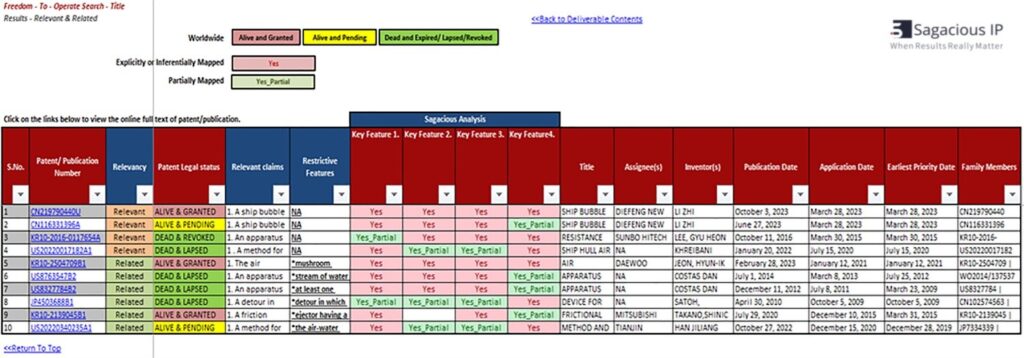The Complete Guide to Mastering FTO Patent Searches
Embarking on the journey of innovation amidst the intricate web of Intellectual Property (IP) laws requires a meticulous approach. At the core of this endeavor lies the critical step of conducting a Freedom to Operate (FTO) patent search— an essential process aimed at ensuring product viability without infringing upon existing patents.
However, to embark on an effective FTO search, it’s imperative to first understand the inherent challenges of this process. Navigating the intricacies of IP laws and delving into vast patent databases present significant hurdles. Recognizing and comprehending these challenges is essential as it sets the groundwork for a more strategic and informed approach to overcoming them.
In this article, we will explore the ten best practices essential for conducting an effective FTO patent search. Each practice serves as a beacon, guiding individuals and organizations through the obstacles while offering comprehensive solutions. From identifying key features to crafting clear and concise reports, our discussion aims to empower readers with the knowledge necessary to navigate the intricate landscape of IP with confidence and precision.
First, let’s explore the ideal stage for conducting FTO searches!
Table of Contents
Ideal Timing for FTO Searches
FTO searches should ideally be performed during the early stages of product development, typically at the ideation phase or before significant investments are made. This ensures timely identification and resolution of potential patent infringement issues, thereby mitigating risks and averting costly legal disputes in the future. By conducting FTO searches early in the process, individuals and organizations can make well-informed decisions regarding product design, development, and market entry strategies, all while safeguarding their intellectual property rights.
Challenges in FTO Searches
Before delving into the best practices for conducting a FTO search, it’s essential to acknowledge the challenges inherent in this process. Navigating the complex landscape of intellectual property laws and patent databases presents several obstacles that need to be addressed to ensure a thorough and effective search. Some of the key challenges include:
- Vast Patent Databases: Millions of documents make efficient filtering challenging without proper tools, risking the oversight of critical patents.
- Legal and Jurisdictional Complexity: Differing intellectual property laws across jurisdictions add complexity, necessitating a nuanced understanding to avoid infringement risks.
- Time Constraints: Comprehensive FTO searches demand time and resources; tight deadlines may compromise quality, leading to potential oversights.
- Identifying Key Features: Defining essential product features accurately is pivotal, especially for complex innovations with multiple components.
- Competitor Analysis: In-depth research is essential to identify key industry players and evaluate their patent portfolios, preventing the oversight of critical patents.
- Dynamic Patent Landscape: Constant evolution in the patent landscape requires staying updated with new grants and expired patents for an effective FTO search.
- Language and Translation Issues: Patents in different languages pose challenges, requiring accurate translations to avoid misunderstandings.
- Resource Allocation: Effectively allocating resources to prioritize high-threat patents is crucial to avoid wasting time and effort on low-risk ones.
- Communication of Findings: Compiling and presenting search results in a clear manner is vital for informed decision-making despite the complexities of legal and technical information.
Addressing these challenges through strategic best practices improves the efficacy of FTO searches, enabling both individuals and organizations to navigate patent landscapes and mitigate infringement risks more effectively.
10 Best Practices for Performing an FTO Patent Search
Let’s delve deeper into each one to understand its significance and application in the FTO patent search process.
1. Prioritizing Vital Key Features
Prioritizing essential features is vital for an effective FTO patent search. Key features are the backbone of the search, requiring clarity and distinction. Before initiating the FTO search, it’s crucial to compare all unique key features to determine the most critical ones. This comparative process aids in pinpointing the primary key features, guiding the search’s focus effectively. By identifying these primary key features initially, attention can be concentrated on specific areas, resulting in a higher quality search. Emphasizing and prioritizing certain key features significantly reduces the risk of overlooking crucial patents, ensuring a thorough and accurate FTO search and yielding better outcomes.Top of Form
For example, let’s consider a modular furniture assembly patent:
Preamble: A modular furniture assembly, comprising:
- Key feature 1: A base member.
- Key feature 2: A transverse member having a hole therein.
- Key feature 3: A cover extending over the transverse member.
- Key feature 4: The cover also having a hole that is aligned with the hole of the transverse member.
- Key feature 5: A coupler configured to selectively couple the base to the transverse member.
- Key feature 6: The coupler selectively extends through the hole to thereby couple the base to the transverse member.
2. Use Multiple Search Databases
Leverage various patent databases, encompassing both free and subscription-based platforms, to conduct a comprehensive search. Prominent databases such as Google Patents, the United States Patent and Trademark Office (USPTO), and the European Patent Office (EPO) grant access to an extensive repository of patent documents. Additionally, consider employing paid databases such as Derwent, Orbit etc. for exhaustiveness. The significance of utilizing multiple databases lies in the diverse coverage they offer, ensuring a more thorough exploration of prior art and potential patent conflicts across a broader spectrum of sources. This approach enhances the reliability and depth of the FTO patent search, providing a more robust foundation for decision-making in intellectual property matters.
3. Comprehensive Jurisdiction Coverage
Jurisdiction is a critical factor in FTO searches. The search must align with the jurisdictions where the client intends to launch its product. Missing out on a crucial patent in a particular jurisdiction could have serious legal implications down the line. For instance, a patent filed in Germany could have different channels – through the German Patent Office, WIPO, or EPO, etc. Neglecting any of these channels might lead to overlooking significant patents, underscoring the necessity for comprehensive coverage.
4. Strategic Date Restriction
Time is a crucial factor in FTO searches, necessitating the setting of date restrictions to narrow down searches to the most relevant patents, typically focusing on those filed within the last two decades within relevant geographies. Nonetheless, intricacies arise, particularly within industries like pharmaceuticals and medical devices, where Patent Term Extension plays a role, necessitating adjustments to date parameters for a thorough examination. Additionally, it’s essential to include expired patents in FTO searches for several reasons:
- Expired patents signify that the associated technology is free to use, eliminating concerns about infringement.
- They offer valuable guidance for improvement, particularly beneficial during the early stages of technology development.
- Expired patents can be utilized to invalidate potentially infringing patents, strengthening the position of the innovator.
- These patents serve as negotiation tools for licensing purposes, facilitating smoother agreements, and reducing associated costs.
- Including expired patents in FTO analysis effectively mitigates overall risk, ensuring a more comprehensive and informed decision-making process.
5. Target Key Players
Understanding your industry’s competition is crucial. Key players often have significant patent portfolios, which must be thoroughly evaluated. Immediate competitors and patents held by patent trolls present potential obstacles to product success and require scrutiny. Prioritize identifying and analysing patents held by these entities to mitigate risks and strengthen your patent strategy.
6. Segmentation for Efficiency
To optimize your patent search efforts, consider segmenting your results based on key factors like claim length and legal status.
- Claim Length: The length of the main independent claim often defines the scope of the invention. Generally, patents with shorter main independent claims tend to have broader coverage. Utilize features in searching databases that provide information on claim length to segregate the patent set accordingly. Prioritize those patents with shorter main independent claims, as they may have wider implications for your project.
- Legal Status: In FTO searches, dividing patents based on their family legal status can provide valuable insights. Focus primarily on active and granted patents, as these are the ones that can potentially pose immediate roadblocks during product launches or other activities. This focused attention ensures that resources are allocated efficiently to analyze patents that are most pertinent to your project.
7. Harness Citation Searches
The backward and forward citations of a patent often serve as the most relevant results within its domain. Following the analysis phase, it’s recommended to perform a citation search for the shortlisted patents. This practice helps uncover any patents that may have been overlooked during the initial search due to factors such as translation errors or missing keywords. Citation searching is thus an essential tool for bolstering the effectiveness of FTO patent searches and ensuring thorough coverage.
8. Leverage Similarity Searches
Leverage the power of similarity search features to pinpoint patents that share similarities with your invention. Broaden your search scope to encompass all pertinent patents, reducing the risk of missing potential obstacles to your product’s market entry. Integrate similarity searches into your FTO search strategy for a comprehensive examination of the patent landscape.
9. Dynamic Keyword and Classification Updates
Adaptability plays a crucial role in the FTO patent search process. It’s essential to continuously update your search parameters, such as keywords and classifications, to keep pace with evolving trends. By refining your search strings and incorporating new terms as they arise, you can maintain a comprehensive and up to date FTO search. Remaining vigilant throughout the process helps minimize the risk of overlooking critical patents.
10. Craft Clear and Comprehensive Reports
Communicate your findings effectively through structured and easily understandable reports. Categorize your search results, prioritize threats, and provide updated legal statuses to empower informed decision-making. A well-crafted FTO report is essential for guiding strategic decisions and minimizing legal risks associated with patent infringement.
- Categorization: Organize patents into “Relevant,” “Potentially Relevant,” and “Related” categories based on infringement potential, ensuring easy comprehension for stakeholders.
- Priority: Arrange patents in decreasing order of threat potential to expedite review processes and focus attention on the most pressing concerns.
- Legal Status: Regularly check and report the legal status of relevant patents, focusing on active and granted patents as immediate roadblocks during product launches.
- Latest Claims: Analyze only the latest claims of active and granted patents from national patent office websites to ensure accuracy in infringement assessment.

Final Thoughts
Conducting an FTO patent search requires diligence, precision, and a thorough understanding of patent law. By following these best practices, you can confidently navigate patent landscapes. Remember, each step interconnects, and ensuring quality is crucial throughout. With Sagacious IP’s expertise and comprehensive FTO search services, embark on your innovation journey with peace of mind, knowing potential roadblocks have been meticulously addressed.

With these strategies available to you, you can conquer the challenges of FTO patent searches and pave the way for innovation without hindrance. Learn more about our comprehensive Freedom to Operate (FTO) search services. If you have any inquiries, don’t hesitate to contact us at [email protected].
-Mani Singhal (Engineering) and Rahul Raj (Editorial Team)




